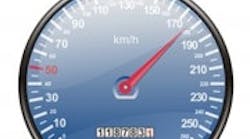Temperature, pressure, flow and their continuous analog I/O signals are big shots in process applications, but their overall role in digital industrial networks and discrete manufacturing outside of areas such as hydraulics has been modest—until recently.
This limited presence was partly because data-heavy analog signals were harder and more costly to bring back and convert from analog to digital in a central location for analysis and/or control.
"Machines and production lines used to be 90% digital I/O and 10% analog I/O, so most users would just add an analog card to their PLC or other controller," says Chris Vitale, senior product manager for distributed I/O at Turck (www.turck.com). "However, in 2007-08, we started to see new machine designs with more analog devices, more accuracy, and four channels on the network or interface instead of the usual two channels. Also, as Ethernet pushed toward the I/O level during the past five or six years, users saw the benefits of having everything on the same network, including having their analog I/O on the same network as their discrete I/O. So we've been making higher-density analog I/O cards and four- and eight-channel devices, and these let users add more I/O devices per node to the network at less cost."
As a result, Vitale adds, developers use these higher-density I/O cards and other digital accessories to deploy thermocouples and resistance temperature detectors (RTDs) in places where they couldn't do it before. "They take A/D converting out of the PLC, and move it into field network I/O devices, so everything appears digital," he says.
"The little slices between adjacent values are so narrow and fast that today's digital I/O signals are becoming indistinguishable from a true analog I/O signal," explains Tom Edwards, senior technical advisor at Opto 22 (www.opto22.com). "In our case, we have 16-bit resolution A/D converting that divides a 16 mA signal into 64,000 parts, so the original and digital signals look the same. Other developers can use far higher resolution for applications that need more precision."
Digital-assisted analog I/O enables a variety of components and applications, such as very low-power wireless sensors for power monitoring or gathering and transmitting plant-floor data over a wide area via mesh networking using ZigBee, Edwards adds. "Over the past year, our PAC controllers and brains added classical and intelligent digital and analog I/O with optical isolation with a wireless connection option," he says. "This lets users manage their analog I/O as part of an overall system. These smaller, networked sensors also let users convert analog signals to digital numbers at the source."
Users want higher-resolution signals for more accurate control, but traditional A/D converting tends to lose some resolution, notes Charlie Norz, product manager for I/O systems at Wago (www.wago.com). "As a result, they're using newer analog I/O tools such as the analog input module in our CTransformer to monitor current, energy consumption and other crucial parameters," he says. "Likewise, our three-phase power monitor can examine the voltage and current of each phase, check for imbalances, and use the analog input module to show power consumption without having to ask a PLC to crunch its numbers. Analog I/O has been around for a while, but now it can be built right into local controllers, and it doesn't need special communications to a controller."
Some analog I/O devices can outperform dedicated data acquisition (DAQ) equipment in some applications, according to Tessa Myers, business manager for ControlLogix, safety control and Ethernet at Rockwell Automation (www.rockwellautomation.com). "It's also easier to coordinate analog I/O into existing control systems," she says.
Christine Bush, engineering manager at Schneider Electric's (www.schneiderelectric.com) OEM Flex Center, adds that it's easier for users to quickly run a bunch of short field wires into a distributed I/O box on one side of a machine, and then run one cable back to a PLC on the other side of the machine or production line. "This lets users get very granular with individual valves or other devices, get the exact I/O they need in the right place, and grow whenever they need it," she says.




